Target Information
| Target General Information | Top | |||||
|---|---|---|---|---|---|---|
| Target ID |
T16263
(Former ID: TTDI02037)
|
|||||
| Target Name |
T-cell-specific protein RANTES (CCL5)
|
|||||
| Synonyms |
Tcellspecific protein RANTES; TCP228; T cellspecific protein P228; T cell-specific protein P228; Smallinducible cytokine A5; Small-inducible cytokine A5; SISdelta; SIS-delta; SCYA5; RANTES(468); Eosinophil chemotactic cytokine; EoCP; D17S136E; CC motif chemokine 5; C-C motif chemokine 5
Click to Show/Hide
|
|||||
| Gene Name |
CCL5
|
|||||
| Target Type |
Clinical trial target
|
[1] | ||||
| Disease | [+] 1 Target-related Diseases | + | ||||
| 1 | Diabetes mellitus [ICD-11: 5A10] | |||||
| Function |
Causes the release of histamine from basophils and activates eosinophils. May activate several chemokine receptors including CCR1, CCR3, CCR4 and CCR5. One of the major HIV-suppressive factors produced by CD8+ T-cells. Recombinant RANTES protein induces a dose-dependent inhibition of different strains of HIV-1, HIV-2, and simian immunodeficiency virus (SIV). The processed form RANTES(3-68) acts as a natural chemotaxis inhibitor and is a more potent inhibitor of HIV-1-infection. The second processed form RANTES(4-68) exhibits reduced chemotactic and HIV-suppressive activity compared with RANTES(1-68) and RANTES(3-68) and is generated by an unidentified enzyme associated with monocytes and neutrophils. May also be an agonist of the G protein-coupled receptor GPR75, stimulating inositol trisphosphate production and calcium mobilization through its activation. Together with GPR75, may play a role in neuron survival through activation of a downstream signaling pathway involving the PI3, Akt and MAP kinases. By activating GPR75 may also play a role in insulin secretion by islet cells. Chemoattractant for blood monocytes, memory T-helper cells and eosinophils.
Click to Show/Hide
|
|||||
| BioChemical Class |
Cytokine: CC chemokine
|
|||||
| UniProt ID | ||||||
| Sequence |
MKVSAAALAVILIATALCAPASASPYSSDTTPCCFAYIARPLPRAHIKEYFYTSGKCSNP
AVVFVTRKNRQVCANPEKKWVREYINSLEMS Click to Show/Hide
|
|||||
| 3D Structure | Click to Show 3D Structure of This Target | AlphaFold | ||||
| HIT2.0 ID | T18SKL | |||||
| Drugs and Modes of Action | Top | |||||
|---|---|---|---|---|---|---|
| Clinical Trial Drug(s) | [+] 1 Clinical Trial Drugs | + | ||||
| 1 | NI-0701 | Drug Info | Phase 1 | Autoimmune diabetes | [2] | |
| Mode of Action | [+] 1 Modes of Action | + | ||||
| Inhibitor | [+] 1 Inhibitor drugs | + | ||||
| 1 | NI-0701 | Drug Info | [1] | |||
| Cell-based Target Expression Variations | Top | |||||
|---|---|---|---|---|---|---|
| Cell-based Target Expression Variations | ||||||
| Drug Binding Sites of Target | Top | |||||
|---|---|---|---|---|---|---|
| Ligand Name: Levovist | Ligand Info | |||||
| Structure Description | Crystal structure of CC chemokine 5 (CCL5) oligomer in complex with heparin | PDB:5DNF | ||||
| Method | X-ray diffraction | Resolution | 2.55 Å | Mutation | No | [3] |
| PDB Sequence |
SSDTTPCCFA
13 YIARPLPRAH23 IKEYFYTSGK33 CSNPAVVFVT43 RKNRQVCANP53 EKKWVREYIN 63 SLEMS
|
|||||
|
|
||||||
| Ligand Name: Pyroglutamic Acid | Ligand Info | |||||
| Structure Description | Crystal Structure of CC Chemokine Receptor 5 (CCR5) in complex with high potency HIV entry inhibitor 5P7-CCL5 | PDB:5UIW | ||||
| Method | X-ray diffraction | Resolution | 2.20 Å | Mutation | Yes | [4] |
| PDB Sequence |
GPPLMALQSC
10 CFAYIARPLP20 RAHIKEYFYT30 SGKCSNPAVV40 FVTRKNRQVC50 ANPEKKWVRE 60 YINSLEM
|
|||||
|
|
||||||
| Click to View More Binding Site Information of This Target with Different Ligands | ||||||
| Different Human System Profiles of Target | Top |
|---|---|
|
Human Similarity Proteins
of target is determined by comparing the sequence similarity of all human proteins with the target based on BLAST. The similarity proteins for a target are defined as the proteins with E-value < 0.005 and outside the protein families of the target.
A target that has fewer human similarity proteins outside its family is commonly regarded to possess a greater capacity to avoid undesired interactions and thus increase the possibility of finding successful drugs
(Brief Bioinform, 21: 649-662, 2020).
Human Pathway Affiliation
of target is determined by the life-essential pathways provided on KEGG database. The target-affiliated pathways were defined based on the following two criteria (a) the pathways of the studied target should be life-essential for both healthy individuals and patients, and (b) the studied target should occupy an upstream position in the pathways and therefore had the ability to regulate biological function.
Targets involved in a fewer pathways have greater likelihood to be successfully developed, while those associated with more human pathways increase the chance of undesirable interferences with other human processes
(Pharmacol Rev, 58: 259-279, 2006).
Biological Network Descriptors
of target is determined based on a human protein-protein interactions (PPI) network consisting of 9,309 proteins and 52,713 PPIs, which were with a high confidence score of ≥ 0.95 collected from STRING database.
The network properties of targets based on protein-protein interactions (PPIs) have been widely adopted for the assessment of target’s druggability. Proteins with high node degree tend to have a high impact on network function through multiple interactions, while proteins with high betweenness centrality are regarded to be central for communication in interaction networks and regulate the flow of signaling information
(Front Pharmacol, 9, 1245, 2018;
Curr Opin Struct Biol. 44:134-142, 2017).
Human Similarity Proteins
Human Pathway Affiliation
Biological Network Descriptors
|
|
|
There is no similarity protein (E value < 0.005) for this target
|
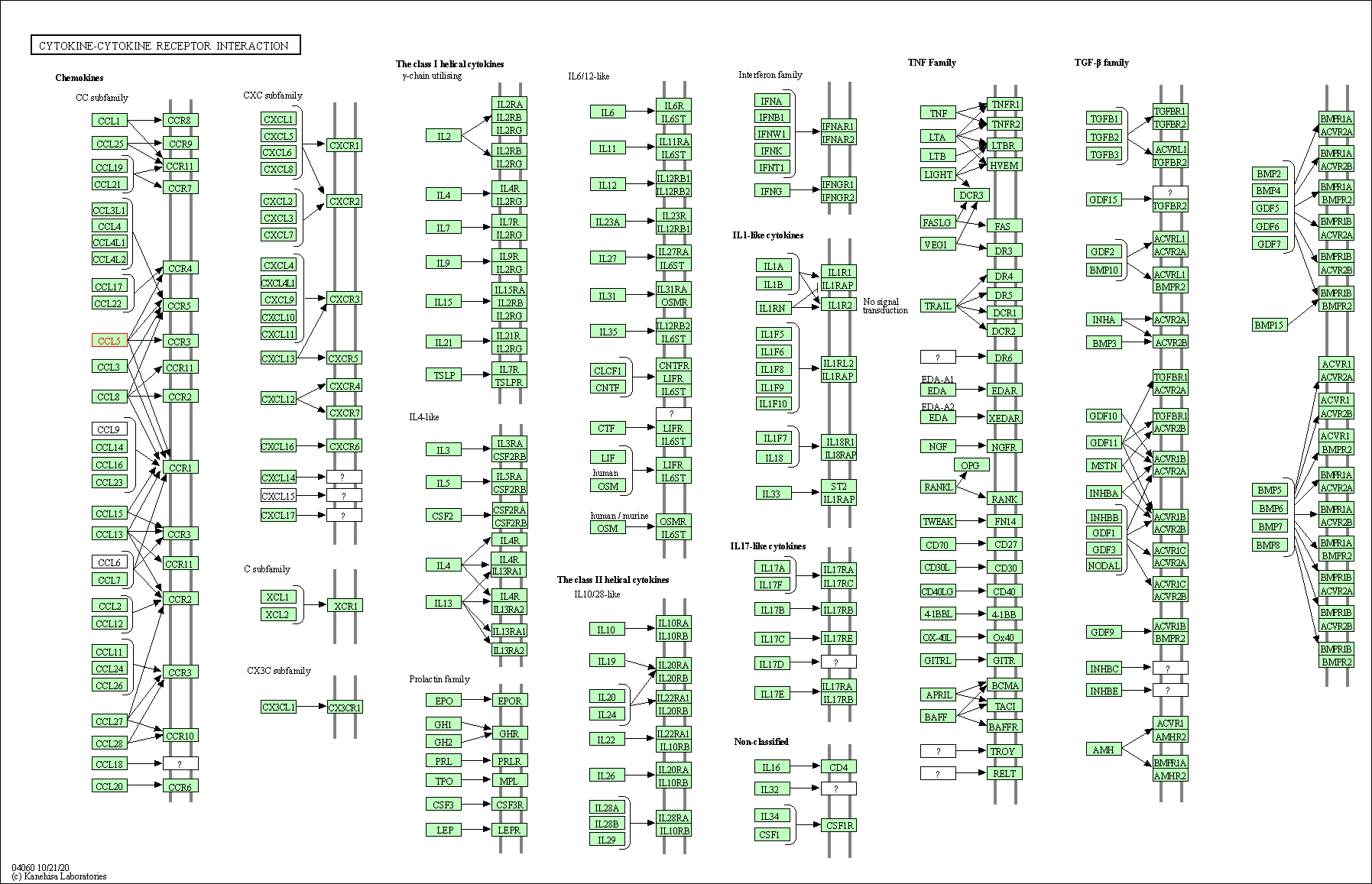

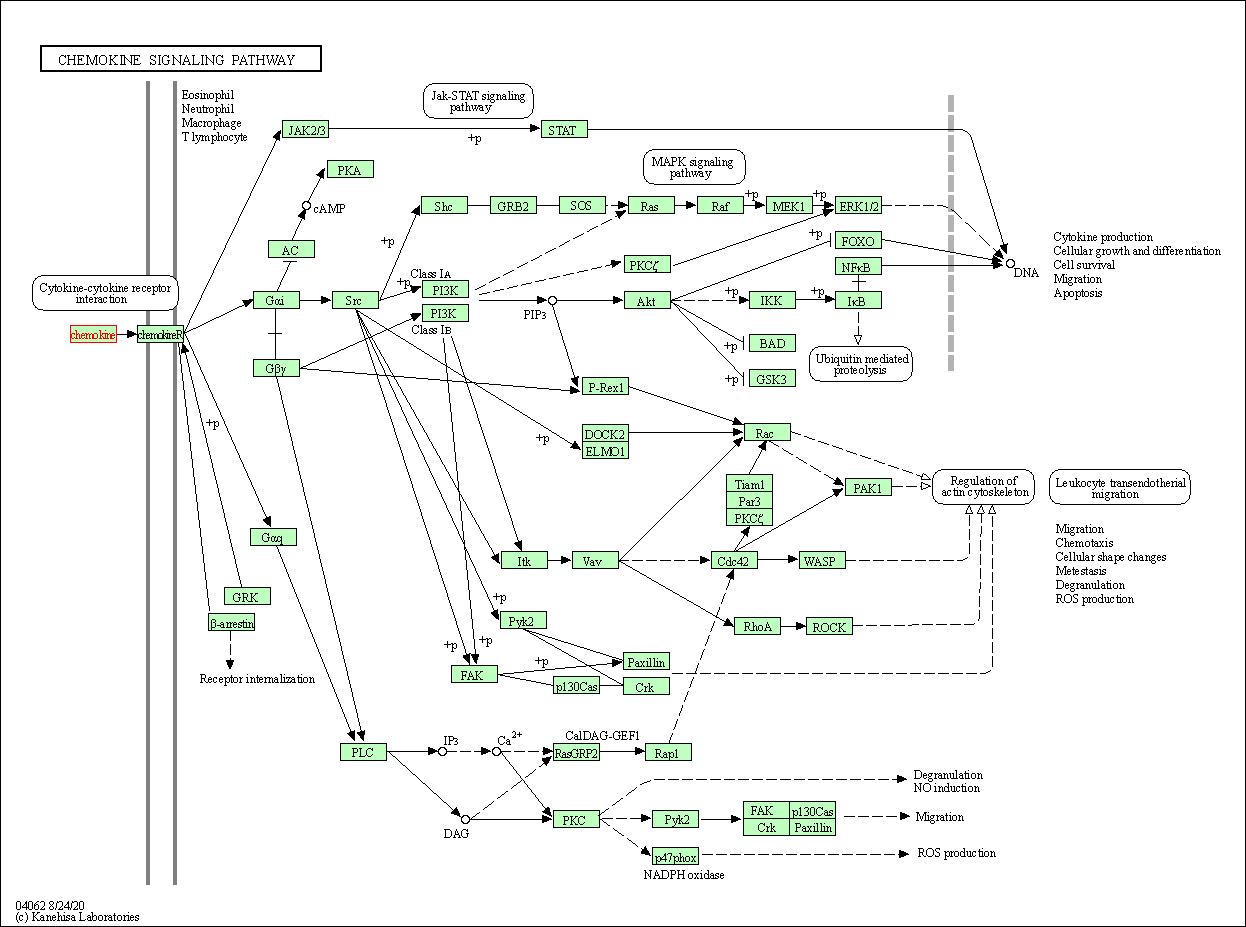
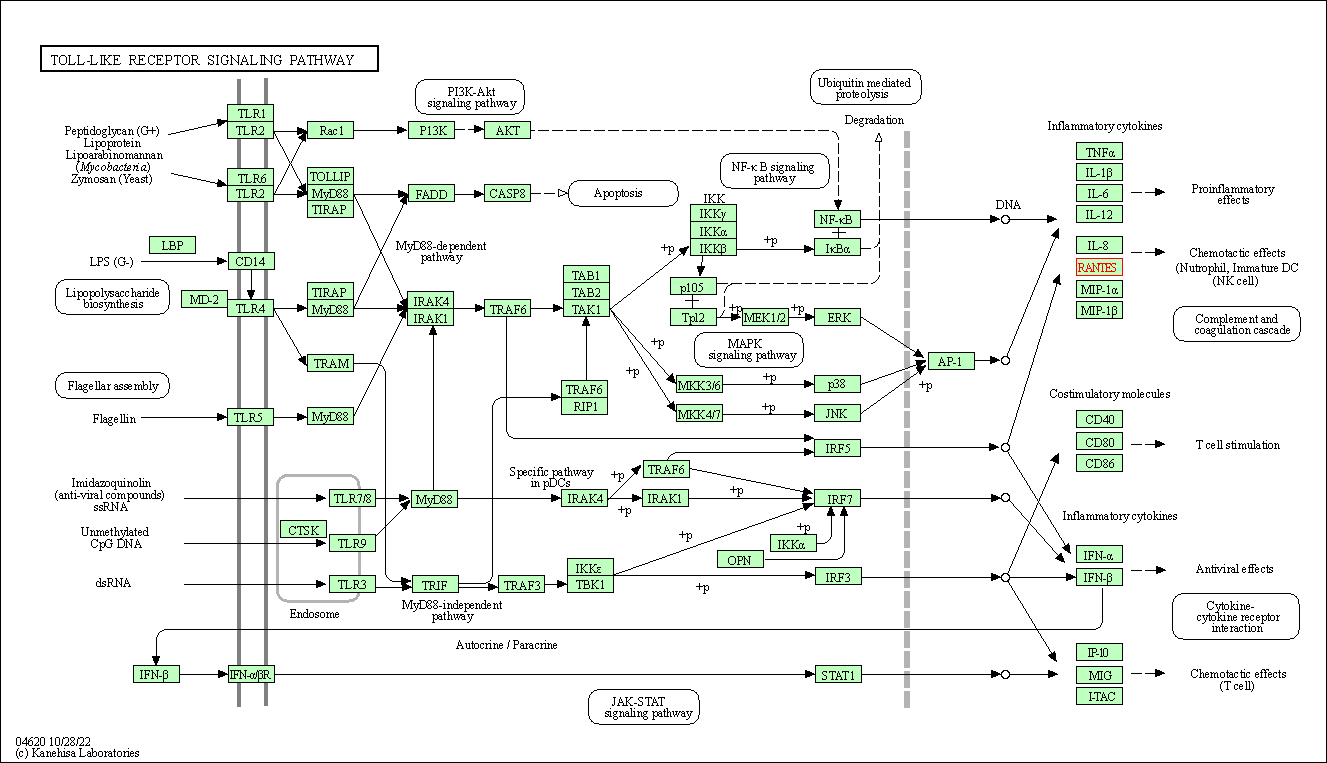
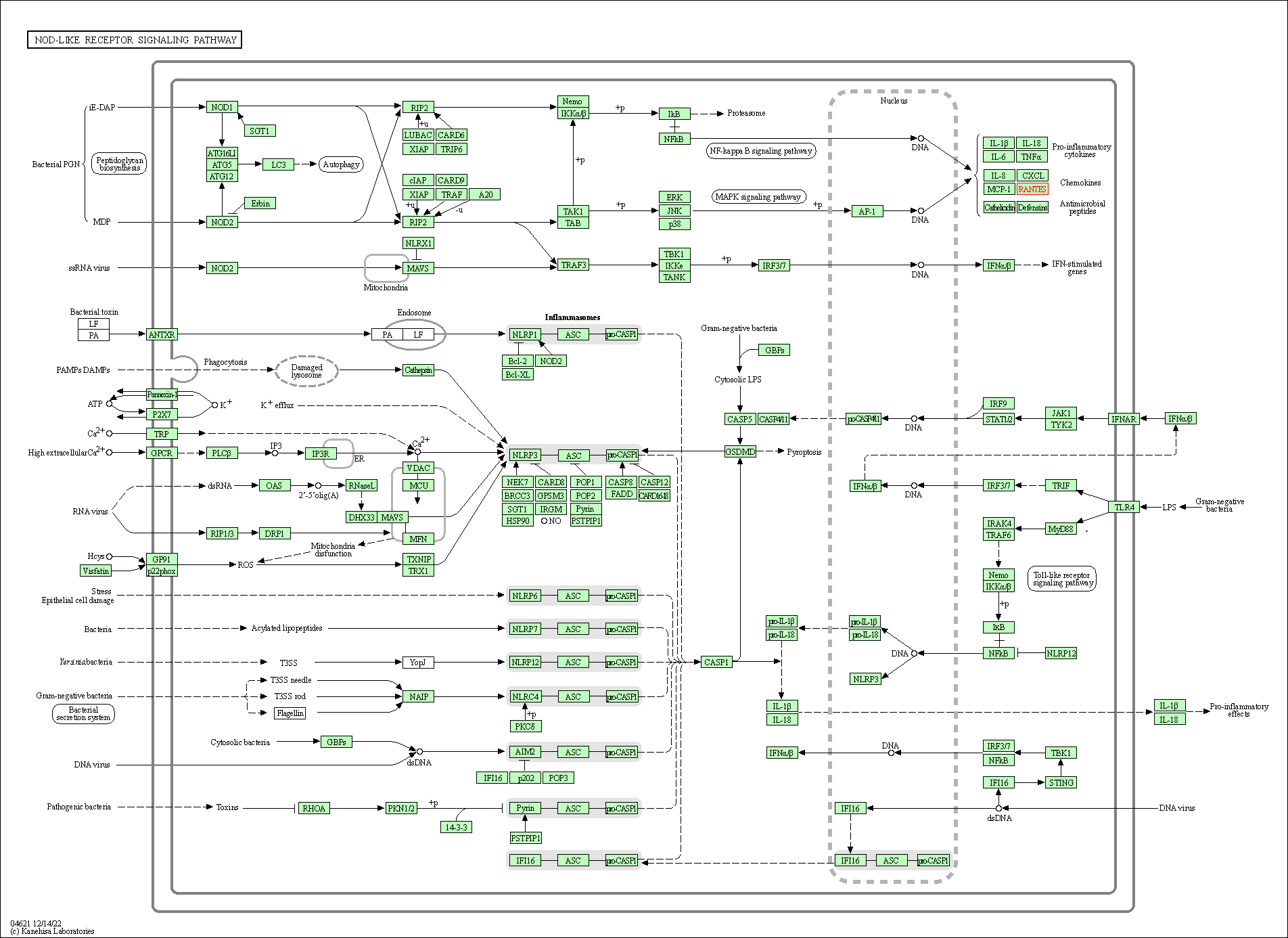
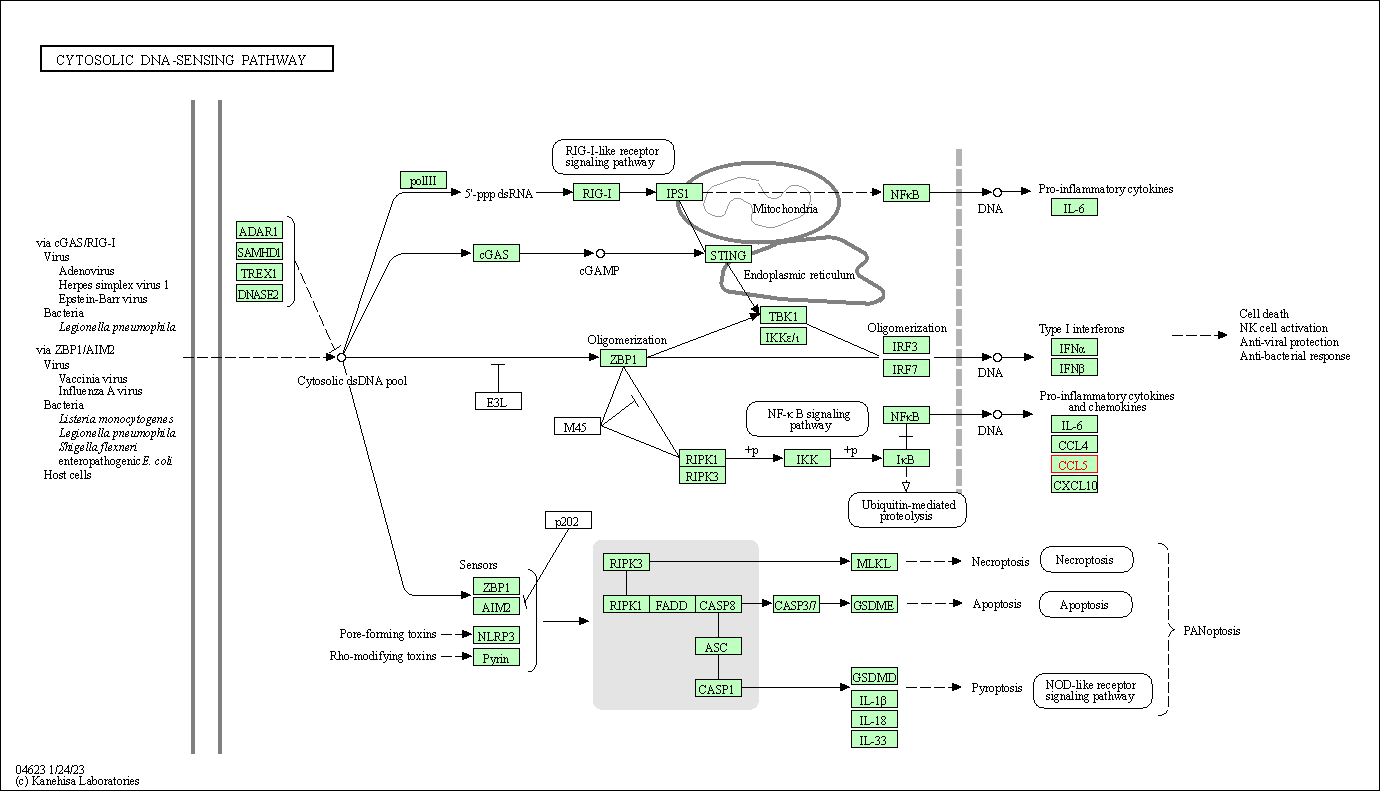
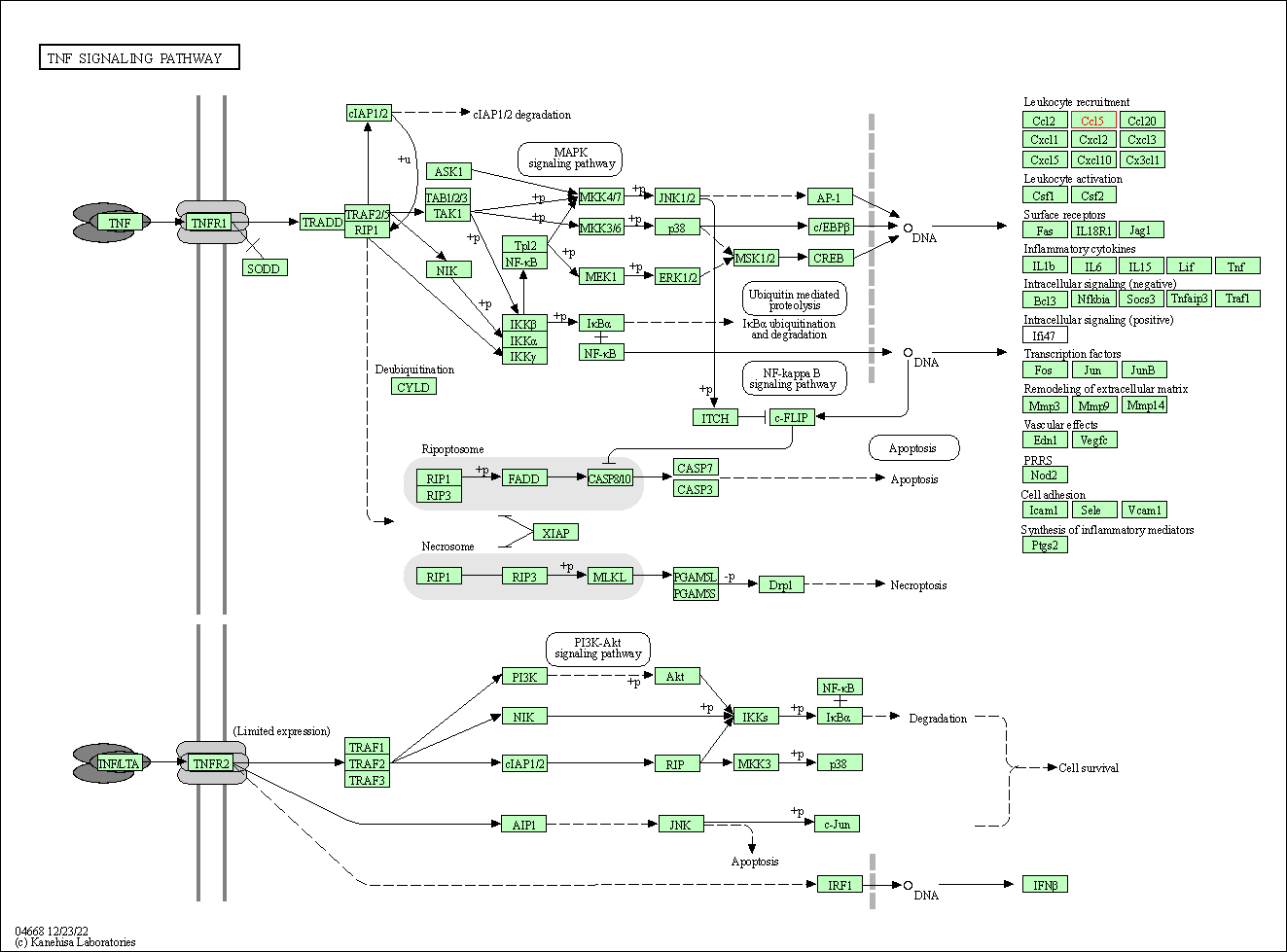
| KEGG Pathway | Pathway ID | Affiliated Target | Pathway Map |
|---|---|---|---|
| Cytokine-cytokine receptor interaction | hsa04060 | Affiliated Target |

|
| Class: Environmental Information Processing => Signaling molecules and interaction | Pathway Hierarchy | ||
| Viral protein interaction with cytokine and cytokine receptor | hsa04061 | Affiliated Target |

|
| Class: Environmental Information Processing => Signaling molecules and interaction | Pathway Hierarchy | ||
| Chemokine signaling pathway | hsa04062 | Affiliated Target |

|
| Class: Organismal Systems => Immune system | Pathway Hierarchy | ||
| Toll-like receptor signaling pathway | hsa04620 | Affiliated Target |

|
| Class: Organismal Systems => Immune system | Pathway Hierarchy | ||
| NOD-like receptor signaling pathway | hsa04621 | Affiliated Target |

|
| Class: Organismal Systems => Immune system | Pathway Hierarchy | ||
| Cytosolic DNA-sensing pathway | hsa04623 | Affiliated Target |

|
| Class: Organismal Systems => Immune system | Pathway Hierarchy | ||
| TNF signaling pathway | hsa04668 | Affiliated Target |

|
| Class: Environmental Information Processing => Signal transduction | Pathway Hierarchy | ||
| Click to Show/Hide the Information of Affiliated Human Pathways | |||
| Degree | 21 | Degree centrality | 2.26E-03 | Betweenness centrality | 4.70E-04 |
|---|---|---|---|---|---|
| Closeness centrality | 2.24E-01 | Radiality | 1.39E+01 | Clustering coefficient | 3.67E-01 |
| Neighborhood connectivity | 2.97E+01 | Topological coefficient | 1.13E-01 | Eccentricity | 11 |
| Download | Click to Download the Full PPI Network of This Target | ||||
| Chemical Structure based Activity Landscape of Target | Top |
|---|---|
| Target Regulators | Top | |||||
|---|---|---|---|---|---|---|
| Target-regulating microRNAs | ||||||
| Target-interacting Proteins | ||||||
| References | Top | |||||
|---|---|---|---|---|---|---|
| REF 1 | Handbook of Therapeutic Antibodies. Stefan D bel, Janice M. Reichert, 2014. Page(1021). | |||||
| REF 2 | ClinicalTrials.gov (NCT01255501) First in Human Study of NI-0701 in Healthy Volunteers. U.S. National Institutes of Health. | |||||
| REF 3 | Structural basis for oligomerization and glycosaminoglycan binding of CCL5 and CCL3. Proc Natl Acad Sci U S A. 2016 May 3;113(18):5000-5. | |||||
| REF 4 | Structure of CC Chemokine Receptor 5 with a Potent Chemokine Antagonist Reveals Mechanisms of Chemokine Recognition and Molecular Mimicry by HIV. Immunity. 2017 Jun 20;46(6):1005-1017.e5. | |||||
If You Find Any Error in Data or Bug in Web Service, Please Kindly Report It to Dr. Zhou and Dr. Zhang.

